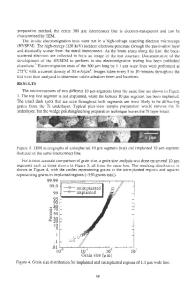Mechanism of Electromigration Failure in Al Thin Film Interconnects Containing Sc
- PDF / 1,813,282 Bytes
- 6 Pages / 414.72 x 648 pts Page_size
- 52 Downloads / 400 Views
substrates with 0.1-Rxm-thick thermal oxide. The films were patterned using a standard dry etching technique to produce test structures containing 25 1-Vm-wide lines. The samples were annealed after patterning at two different temperatures (500 0C and 550°C) for up to 2 hrs. The samples were air-quenched in order to retain the Sc in solid solution. The lines were then tested under a current density of 1.2x10 6 A/cm 2 at the substrate temperature of 225C(2. Some of the lines were aged at 2250 C for various times before testing. The median time to failure (MTF) and deviation of time to failure (DTF) were measured by fitting the lifetimes to log-normal distribution. A minimum of two independent tests were performed to validate each set of results. RESULTS AND DISCUSSION Microstructure The microstructural examination of the film before anneal revealed that grains are smaller than 0.2gm and randomly oriented for both Al-Sc and pure Al. Grain growth in the Al-Sc alloy is different from that of pure Al; first, the kinetics of grain growth decrease as Sc concentration increases. Second, abnormal grain growth is more pronounced for Al-Sc films. Fig.1 shows the typical microstructure of an Al-0.3Sc after a 60 min. anneal at 550*C and aging for 20 hrs at 225'C. This TEM micrograph shows the bimodal nature of grain structure. Fig.2 also shows the bimodal distribution of grains developed in Al-01Sc by post-pattern annealing at 500°C for 60 min. It can be seen that fairly small grains are bounded by bamboo grains. In general, solutes in Al alloys retard grain growth, since solutes tend to decrease grain boundary motion. The effectiveness of Sc as a grain refiner has been well characterized in previous studies [3]. Furthermore, the presence of A13Sc precipitates plays a more significant role on grain growth than Sc in solution. The solubility of Sc in Al is approximately 0.06 and 0.12% at 500"C and 550'C, respectively [7]. Therefore, Sc in the Al-0.1Sc alloy at 550 0 C should be in solid solution, while precipitates should form in Al0.3Sc alloy. This can explain the grain Fig.1 TEM micrograph showing a grain structure in at 5500C growth kinetics differences between AI-0.3Sc film, after 60 min. annealing films containing 0.1 and 0.3Sc. and subsequently aged at 225 0 C for 20 hrs. TEM investigation of aged samples showed that precipitates formed inside the grains were coherent and disc shaped. Fig.1 shows stable incoherent precipitates along grain boundaries. With further aging, grain boundary precipitates coarsen by depleting Sc from the matrix. The coarsening kinetics were found to be very slow, probably because of the high stability of precipitates in the Fig.2 TEM micrograph showing a line structure matrix. Even after several days of aging found in A1-0.1Sc, after post pattern annealing at 225°C, a large number of coherent at 500'C for 60 min. precipitates were still present in the matrix.
290
I
100
b
.0 U.15c,annealed at 30-C
0. 1Sc, annealed at 550'C
800.8 .00
/
.
40
..
O.1Sc, annealed at 5500°C
/
0. 1canneale
Data Loading...











